
© Gérard Bottino / Shutterstock.com
Except in China, all-electric buses are still far from being the norm in urban fleets. But the market is expected to grow rapidly in the coming years, especially in Europe.
1.2%: That was the share of European city buses that were 100% electric in 2013. A tiny portion, but one that is expected to grow rapidly. According to market research firm TechSci Research, the global market for electric buses should grow 17% each year from now until 2021.
The market potential opening up to vehicle manufacturers and electrical service operators is most certainly colossal. The Eur0pean Union aims to reduce greenhouse gas emissions by at least 80% by 2050. Yet nearly half of all buses in Europe are still of Euro III standard or older, that is, in operation since 1999 or before. It is therefore time for renewal, with priority going to clean vehicles.
Less than 1,000 vehicles in Europe
Where do European cities stand in their investment plans? In January 2017, the ZeEUS project (Zero Emission Urban Bus System) published an extensive overview of electric buses in operation today, with a look at 61 cities around Europe that are either operating or testing all-electric buses with a capacity of 55 passengers or more.
The European fleet—as counted in the area surveyed by ZeEUS—contains 956 purely electric vehicles, either in circulation or on order. With 18% of this total, the United Kingdom is the country in the lead for adopting all-electric fleets, ahead of the Netherlands, Sweden, Poland and Germany, which each account for around 10% of this market. In France, the percentage of 100% electric vehicles is even more modest, but in 2025, all buses in major urban centres are expected to be “clean.” In Argenteuil (Val-d’Oise), starting in April 2017, the city’s public transportation fleet will include four 100% rechargeable electric buses, for a total of ten by 2018.
In terms of renewing their fleets, the report shows that 19 public transport operators and authorities, covering about 25 cities, have published a strategy for the introduction of electric buses by 2020. By that date, there should be more than 2,500 electric buses operating in the cities concerned, representing 6% of their total fleet of 40,000. Another 13 public transport operators and authorities in some 18 cities have a strategy with a 2025 horizon; by then, they are expected to have more than 6,100 electric buses in service, representing 43% of their total fleet of 14,000.
Leading the way in all categories, China currently holds 98.3 % of the global fleet, with 170,000 electric buses in operation.
And elsewhere in the world? In 2016, about 200 electric buses were ordered in the United States, with the state of California making the most purchases. In Russia, India and Latin America, public transport operators are still at the experimentation stage. In Australia, the city of Adelaide is studying the suitability of a solar-powered bus system.
If there is one economic fact that characterizes the global market for electric buses, it is the overwhelming predominance of China, which currently holds 98.3% of the global fleet, with 170,000 electric buses in operation (six times more than the previous year). And it will not stop there. For example, Shenzhen City alone (10 million inhabitants) plans to electrify its entire fleet of 16,500 vehicles by the end of 2017.
Significant growth potential
It is true that China is home to a large number of manufacturers, including the world leader, BYD, which is now tackling the European market with a model adapted to usage habits on the Old Continent.
Around the word, and notably in Europe, the growth potential for a full-fledged electric bus market is considerable. According to ZeEUS, a European series production of electric buses should reach full maturity by 2018-2020. What remains is to remove the primary economic constraint: the upfront cost of electric buses and their charging infrastructure can be inhibitive when compared to “conventional” systems. However, the higher purchase cost is later offset by a lower usage cost.
28/02/2017
Learn more:
Smart Charging for 100% Electric Buses


